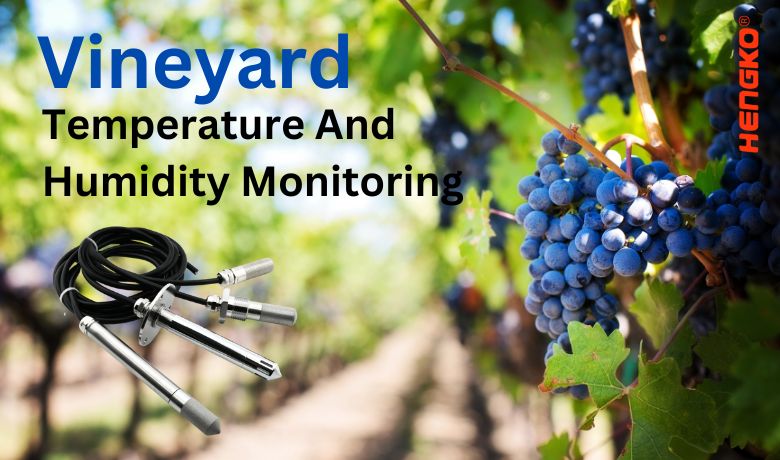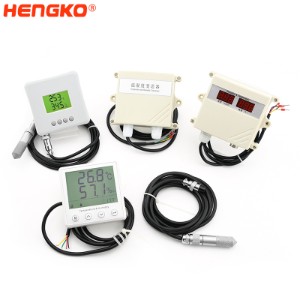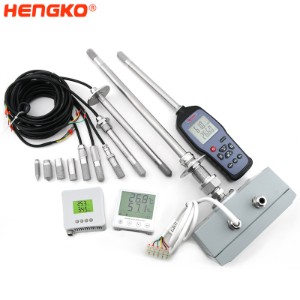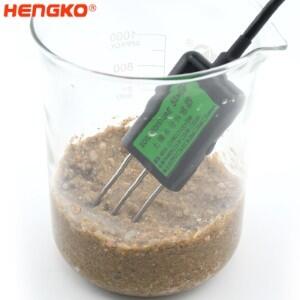
Why it is so important Vineyard Temperature And Humidity Monitoring
Vineyard managers, grape growers, and winemakers know that it can be difficult to maintain the conditions for healthy growth and a quality harvest. To ensure healthy vines, it is necessary to pay close attention to environmental factors such as temperature, humidity, and soil moisture.
Because environmental conditions vary throughout the vineyard, it can be challenging to conduct field inspections to manually monitor each area 24/7. These variable conditions make local weather forecasts unreliable, as their geo-referencing does not always reflect what is happening in the vineyard.
I. Temperature And Humidity Monitoring Systems.
Installing a remote temperature and humidity sensor system allows users to access real-time data from where the plants are located, so they can take the necessary steps to protect them from dangerously high temperatures, low temperatures, and humidity.
When a temperature and humidity IoT monitoring system detects a sensor reading outside of a preset range, it sends a notification to a designated person via phone, text message, or email. They can then act quickly to protect the plants from excessive temperatures and prevent serious damage to the entire vineyard.
The cloud-based remote monitoring system also stores wireless temperature and humidity sensor data from the field to help operators identify trends in conditions. Real-time and historical data allows operators to adjust their programs to more efficient crop management conditions. the HT802 Series industrial-grade temperature and humidity sensor offer high accuracy (±2 % RH) and excellent temperature compensation. It has excellent protection against condensation and contamination, is easy to install, and has a rugged sensor element.
II. Frost Protection.
Monitoring the air temperature and humidity near the vines also helps protect against frost. Vineyard managers receive real-time alerts when readings enter the danger zone and can quickly initiate frost protection measures. The temperature range measured needs to be adjusted according to the vine's hardiness and dormancy status. In short, dormant winter buds can resist colder temperatures rather than new tender spring growth.
When frost forms ice in the plant tissues, it can damage the vines and buds. One way to protect vines from frost is to use an overhead sprinkler. This quick, continuous spray of water creates a frozen coating around the buds and shoots, protecting them from frost damage. This is because water releases heat as it changes from a liquid to a solid. Data from the temperature and relative humidity sensors let operators know when they need to turn sprinklers on and off.
Vineyard operators also use wind turbines as a frost protection measure. Wind machines pull warmer air down from above the colder layers around the plants, thereby increasing the temperature around sensitive shoots. Because every degree and every minute counts, the use of temperature and humidity sensors is critical to allow crews enough time to reach the vineyard and start the fans to reduce the risk of frost damage. Even when wind turbines have sensors and automatic start-ups, remote monitoring systems alert users before temperatures reach dangerously low levels, giving them time to act before it's too late.
In addition to helping vineyard operators save their crops, using a remote monitoring system can also help them save money. Since both sprinkler systems and wind turbines are expensive to run, knowing the exact time to start and end the operation of this equipment means reduced energy costs.
iii. Heat Dissipation.
Extreme heat can damage the delicate flowers and the grapes themselves, especially as they become more ripe and ready for harvest, leading to catastrophic losses. By using remote monitoring systems and temperature sensors, vineyard operators can determine the measures needed to reduce fruit exposure. Temperature data can provide the information needed to determine appropriate cooling methods, such as irrigation, pruning, canopy management, and protective granular films.
IV. Moisture And Humidity Control.
Moisture ats all around the plant - in the atmosphere, in precipitation, in the soil, and the vines themselves. Humidity sensors and soil moisture sensors are an important part of a vineyard water management program. Monitoring moisture is critical to prevent mold and mildew from damaging fruit and vines. Analyzing trends in moisture data helps growers identify early warnings of conditions best suited to breed disease.
Information from soil moisture transmitters can help operators develop the correct irrigation schedule for each part of the vineyard in different seasons. Data from these sensors is important for determining how much water is needed and for how long. It can also help growers understand which plants use the most water and which soil areas take up or retain more water than others.
V. Data Logging
Data history is valuable for identifying patterns and trends in environmental conditions. Many monitoring systems automatically save information, recording tens of thousands of data points, dates, and times. Cloud-based data logging provides users with an unlimited number of records to view, plot, print, and export data trends. Analyzing data samples provides insight into larger issues and prevents problems before they arise. For example, historical data can help identify specific areas of vineyard terrain that are more susceptible to frost and extreme heat at certain times of the day, week, month, and year. If you have any questions about selecting and installing a remote monitoring system in your vineyard, HENGKO's experts will be happy to help you choose the best solution for your operation.
What you should care when Vineyard Temperature And Humidity Monitoring
Monitoring temperature and humidity in a vineyard is a critical part of maintaining healthy vines and ensuring a successful crop. Here are some important factors to consider:
1. Sensor Accuracy and Calibration:
Ensure your monitoring equipment is accurate and well-calibrated. A slight deviation in recorded temperature or humidity can significantly affect the grapes' quality and quantity.
2. Location:
Install the sensors at various points across the vineyard. Climate conditions can vary within the vineyard due to terrain, soil quality, and the presence of water bodies.
3. Height:
Position the sensors at the height of the grape canopy. This gives a better understanding of the microclimate the grapevines are experiencing, which can be different from the ground temperature or the air temperature above the vines.
4. Data Collection Frequency:
More frequent data collection allows for quicker responses to changes in conditions. It helps to identify potential issues early and to take necessary actions.
5. Interpreting Data:
The data collected is valuable only when properly analyzed. Know what temperature and humidity ranges are optimal for your particular type of grape. Excessive heat or cold, or too much or too little humidity, can cause stress to the vines, affecting fruit quality.
6. Preventive Measures:
Use the data to guide your vineyard management practices. For instance, if humidity is often high, consider measures to improve airflow around the vines, like strategic pruning or changing row orientation.
7. Integrated Pest Management:
Temperature and humidity are critical factors for the growth of many diseases and pests in the vineyard. Use the data for effective pest and disease management.
8. Backup Systems:
Have a backup system in place to record data in case your primary system fails.
9. Data Security:
If you are using a digital monitoring system, ensure the data is secure. It could be valuable to competitors, so protect it appropriately.
10. Updates and Maintenance:
Regularly update your systems and maintain the equipment to ensure it's providing accurate readings.
Remember, maintaining the right balance of temperature and humidity can greatly affect the vineyard's productivity and the quality of the grapes. An effective monitoring system is a worthwhile investment for any vineyard.
Why or Benefit of Temperature And Humidity Monitoring for Vineyard ?
Temperature and humidity monitoring can offer significant benefits to vineyard management and grape production. Some of these benefits include:
1. Optimized Grape Quality:
Temperature and humidity greatly influence the grape's growth, sugar content, and flavor profile. By closely monitoring these factors, vineyard managers can create the ideal conditions for each grape variety, optimizing the quality of the fruit and, by extension, the wine.
2. Disease and Pest Prevention:
Many pests and diseases thrive in certain temperature and humidity ranges. Monitoring these conditions can provide early warning signs of potential outbreaks, allowing for proactive measures.
3. Irrigation Management:
Monitoring humidity can help vineyard managers optimize their irrigation schedule, ensuring that vines receive the right amount of water and improving water efficiency.
4. Frost Protection:
Monitoring temperature can help predict frost events, which can damage or even kill vines. Early warnings can allow for protective measures to be put in place.
5. Heat Stress Mitigation:
Too much heat can negatively affect grapevines, leading to sunburned fruit and hampered photosynthesis. Real-time temperature monitoring can help vineyard managers take timely measures, like increasing irrigation or employing shade cloths, to protect the vines.
6. Harvest Planning:
The ripeness of the grapes at harvest significantly impacts the resulting wine's character. Temperature and humidity influence ripening speed, so careful monitoring can assist in planning the optimal harvest time.
7. Climate Change Adaptation:
Long-term temperature and humidity data can help vineyard managers understand local climate trends and adapt their practices accordingly. This is especially important with the ongoing impacts of climate change.
8. Research and Development:
Data collected from monitoring systems can aid in research and development efforts, providing valuable information for studies on new grape varieties, vineyard management techniques, and more.
9. Cost Savings:
By helping to optimize water use, prevent disease, and improve grape quality, temperature and humidity monitoring systems can lead to significant cost savings in the long run.
10. Data-driven Decisions:
With accurate temperature and humidity data, vineyard managers can make more informed decisions, leading to better vineyard management and improved outcomes.
In conclusion, the benefits of temperature and humidity monitoring in a vineyard are manifold, impacting everything from daily operations to long-term planning and sustainability efforts.
Are you looking to optimize your vineyard's temperature and humidity monitoring system? We have the perfect solution for you. Reach out to HENGKO, a trusted leader in precision environmental monitoring solutions.
Don't miss this opportunity to elevate your vineyard's productivity and wine quality. Send an email now to ka@hengko.com to discuss your needs and explore the best solutions for your vineyard.
Experience the HENGKO difference – exceptional service, superior products, and solutions that truly cater to your needs. Contact us today!
Post time: Sep-02-2022








